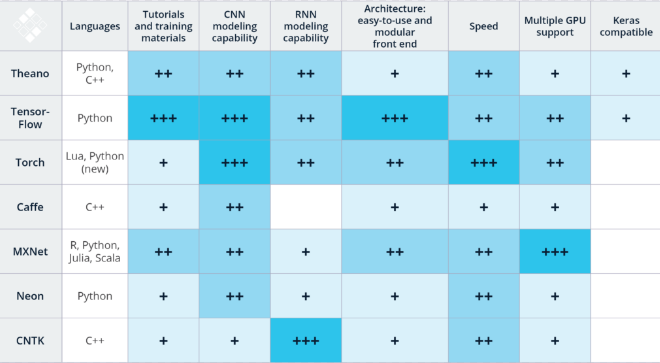This article was written by Matthew Rubashkin. With a background in optical physics and biomedical research, Matthew has a broad range of experiences in software development, database engineering, and data analytics.
At SVDS, our R&D team has been investigating different deep learning technologies, from recognizing images of trains to speech recognition. We needed to build a pipeline for ingesting data, creating a model, and evaluating the model performance. However, when we researched what technologies were available, we could not find a concise summary document to reference for starting a new deep learning project.
One way to give back to the open source community that provides us with tools is to help others evaluate and choose those tools in a way that takes advantage of our experience. We offer the chart below, along with explanations of the various criteria upon which we based our decisions.
These rankings are a combination of our subjective experiences with image and speech recognition applications for these technologies, as well as publicly available benchmarking studies. Please note that this is not an exhaustive list of available deep learning toolkits, more of which can be found here. In the coming months, our team is excited to checkout DeepLearning4j, Paddle, Chainer, Apache Signa, and Dynet. We explain our scoring of the reviewed tools below:
Languages: When getting started with deep learning, it is best to use a framework that supports a language you are familiar with. For instance, Caffe (C++) and Torch (Lua) have Python bindings for its codebase, but we would recommend that you are proficient with C++ or Lua respectively if you would like to use those technologies. In comparison, TensorFlow and MXNet have great multi language support that make it possible to utilize the technology even if you are not proficient with C++.
Note: We have not had an opportunity to test out the new Python wrapper for Torch, PyTorch, released by Facebook AI Research (FAIR) in January 2017. This framework was built for Python programmers to leverage Torch’s dynamic construction of neural networks.
To read the original article, click here.
Top DSC Resources
- Article: What is Data Science? 24 Fundamental Articles Answering This Question
- Article: Hitchhiker’s Guide to Data Science, Machine Learning, R, Python
- Tutorial: Data Science Cheat Sheet
- Tutorial: How to Become a Data Scientist – On Your Own
- Categories: Data Science – Machine Learning – AI – IoT – Deep Learning
- Tools: Hadoop – DataViZ – Python – R – SQL – Excel
- Techniques: Clustering – Regression – SVM – Neural Nets – Ensembles – Decision Trees
- Links: Cheat Sheets – Books – Events – Webinars – Tutorials – Training – News – Jobs
- Links: Announcements – Salary Surveys – Data Sets – Certification – RSS Feeds – About Us
- Newsletter: Sign-up – Past Editions – Members-Only Section – Content Search – For Bloggers
- DSC on: Ning – Twitter – LinkedIn – Facebook – GooglePlus
Follow us on Twitter: @DataScienceCtrl | @AnalyticBridge

